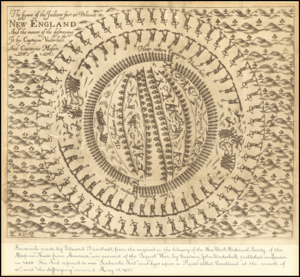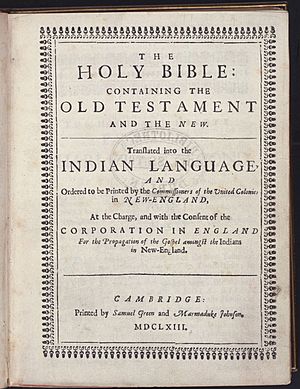Pequots facts for kids

Pequot Museum Exhibit showing Mashantucket Pequot warrior
|
|
| Total population | |
|---|---|
| 1620: 16,000 (est.) 1637: 3,000 (est.) |
|
| Regions with significant populations | |
| Eastern Pequot Tribal Nation, Lantern Hill, North Stonington, Connecticut: 1,130 Mashantucket Pequot Tribe or Western Pequot, Ledyard, Connecticut: 350 |
|
| Languages | |
| Historically Pequot, a dialect of the Mohegan-Pequot language (an Algonquian language), now English | |
| Religion | |
| Native American religion, Christianity |
|
| Related ethnic groups | |
| Mohegan/Mohigan |
The Pequot are a Native American people. They originally lived in Connecticut. Today, many Pequot people are part of the Mashantucket Pequot Tribe. This tribe is officially recognized by the United States government. Other Pequot groups are recognized by the state of Connecticut, like the Eastern Pequot Tribal Nation. Some Pequot descendants also live with the Brothertown Indians in Wisconsin.
Historically, the Pequot spoke a language called Pequot. It was a dialect of the Mohegan-Pequot language. This language mostly disappeared by the early 1900s. However, some tribal members are now working hard to bring it back.
The Pequot and the Mohegan people were once one group. But in the 1600s, the Mohegan separated. This happened as the Pequot gained control over much of Connecticut. Growing tensions with the English colonies led to the Pequot War from 1634 to 1638. This war greatly reduced the number of Pequot people and their power. Many were killed, enslaved, or forced to leave their homes.
A small number of Pequots stayed in Connecticut. They received special lands called reservations. One was at Mashantucket in 1666. Another was near the Pawcatuck River in 1683. Other Pequots lived in different areas or with other tribes. In the 1700s, some Christian Pequot joined other groups. They formed the Brothertown Indians in western New Hampshire. Later, they moved to western New York in the 1800s. The Oneida people of the Iroquois League gave them land. Eventually, they moved to Wisconsin, where they received a reservation.
The Mashantucket Pequot Tribe was officially formed in 1975. The U.S. government recognized them in 1983. This happened as part of a land claim agreement. In 1986, they opened the Foxwoods Resort Casino on their land. This casino is near the New York City area. It has become one of the most successful Native American casinos in the country.
The Pequot people from the Pawcatuck River area formed the Eastern Pequot Tribal Nation. Connecticut recognizes this group. However, the U.S. government does not currently recognize them. Pequot descendants are also part of other recognized tribes. These include the Mohegan Tribe, the Schaghticoke Tribal Nation, and the Golden Hill Paugussett Indian Nation in Connecticut. The Brothertown Indians of Wisconsin also have Pequot members. The Poospatuck Reservation on Long Island is home to several hundred people who identify as Pequot descendants.
Contents
History of the Pequot People
What Does "Pequot" Mean?
The word Pequot comes from an Algonquian word. Its exact meaning is still debated by language experts. Some scholars believe it means "the destroyers" or "the men of the swamp." However, Frank Speck, a language expert from the early 1900s, thought it meant "the shallowness of a body of water." This makes sense because the Pequot lived along the coast of Long Island Sound.
Historians once debated if the Pequot moved to Connecticut around 1500. Some thought they came from the upper Hudson River Valley. However, much evidence now shows that the Pequot were not newcomers. They had lived in the Connecticut River Valley for thousands of years.
By the time the Plymouth and Massachusetts Bay colonies were founded, the Pequot were very powerful. They had strong political, military, and economic control in central and eastern Connecticut. They lived along the coast between the Niantic tribe and the Narragansett in western Rhode Island. About 16,000 Pequot people lived in this area.
A smallpox epidemic from 1616 to 1619 killed many Native Americans. But it did not reach the Pequot, Niantic, and Narragansett tribes. In 1633, the Dutch set up a trading post in Hartford. They killed the main Pequot leader, Tatobem, after a disagreement. The Pequot paid a large amount to get his body back. His successor was Sassacus.
In 1633, another epidemic hit all the tribes in the region. Historians believe the Pequot lost 80 percent of their people. By the start of the Pequot War, only about 3,000 Pequot survivors remained.
The Pequot War (1636–1638)
In 1636, members of the Pequot tribe killed a person from the Connecticut Colony. This event led to war. The Mohegan and Narragansett tribes joined the colonists against the Pequot. Around 1,500 Pequot warriors were killed in battles or hunted down. Others were captured and sold as slaves or servants. Some escaped and joined the Mohawk and Niantic tribes on Long Island.
Eventually, some Pequot returned to their traditional lands. Family groups of friendly Pequots had stayed there. Most of the enslaved Pequots were given to the allied tribes. Many were also sold as slaves in Bermuda. The Mohegans treated their Pequot captives very harshly. Because of this, officials from Connecticut Colony eventually removed them. Connecticut created two reservations for the Pequots in 1683. These were the Eastern Pequot Reservation in North Stonington, Connecticut and the Western Pequots (or Mashantucket Pequot Reservation) in Ledyard.
Modern Pequot History
By 1910, the census showed only 66 Pequot people. Their numbers reached their lowest point a few decades later. However, the Pequot population grew a lot during the 1970s and 1980s. This was especially true for the Mashantucket Pequot tribe. Their tribal chairman, Richard A. Hayward, encouraged them to return home. He worked to get federal recognition and help their economy grow.
In 1976, the Pequots filed a lawsuit. They wanted to get back land they believed was illegally sold in 1856. After seven years, they reached a settlement. The Connecticut government asked the federal government to recognize the Mashantucket Pequots. On October 18, 1983, President Ronald Reagan signed the "Mashantucket Pequot Indian Land Claims Settlement Act." This law gave federal recognition to the Mashantucket Pequot tribe. It allowed them to buy land and put it into a special trust with the Bureau of Indian Affairs for reservation use.
In 1986, they started a bingo operation. Then, in 1992, they opened the first part of Foxwoods Resort Casino. Money from the casino helped them build a cultural museum. It opened on August 11, 1998, on the Mashantucket Pequot Reservation. Many tribal members still live there today.
The Eastern Pequot Tribal Nation was recognized in 2002. Since the 1930s, there had been disagreements between Pequot tribes about who was truly Pequot. Two groups of Eastern Pequots asked for recognition. They agreed to unite to achieve it. However, the state of Connecticut challenged this decision. In 2005, the Department of the Interior took away their recognition. They also took away recognition for the Schaghticoke tribe that same year. The Connecticut government and its representatives in Congress did not want these tribes to be recognized. They were worried the newly recognized tribes would open casinos.
Where Pequot People Live Today
The Eastern Pequot Tribal Nation has 1,130 members. They have a reservation called "Lantern Hill." The state of Connecticut recognizes this tribe.
The Mashantucket Pequot (or Western Pequot) tribe has over 800 members. They gained federal recognition in 1983. Their reservation is in Ledyard.
The Poospatuck Reservation on Long Island is also home to several hundred people. They identify as Pequot descendants.
Most people who identify as Pequot live in these two main communities. They have mixed backgrounds but identify as Pequot. No members of the tribe have only full Pequot ancestry.
Pequot Language Revival
In the past, the Pequots spoke a dialect of the Mohegan-Pequot language. This was an Eastern Algonquian language. After the Pequot War ended in 1637, the colonists made speaking the language a serious crime. Because of this, the language mostly died out within a generation. Today, Pequot people from both the Eastern Pequot Tribal Nation and the Mashantucket Pequot speak English as their main language.
In the 21st century, the Mashantucket Pequot are working hard to bring their language back. They are carefully studying old documents that contain Pequot words. They also compare these words to similar languages that still exist. So far, they have found over 1,000 words. This is a good start, but it's a small part of what's needed for a full language. The Mashantucket Pequots have started offering language classes. They are getting help from the Mashpee Wampanoag people. The Wampanoag recently started their own Wôpanâak Language Reclamation Project. Several Native American communities in southern New England are part of this project. These include the Mashpee Wampanoag, Aquinnah Wampanoag, Herring Pond Wampanoag, and Mashantucket Pequot.
Notable Pequot People
- William Apess (1798–1839) was a Methodist minister and writer. He was of Pequot and European descent. He was also a leader in politics and religion in Massachusetts.
- Willy DeVille (1950–2009) was a rock and roll guitarist, songwriter, and singer. He was Pequot through his mother's family. He explored his Pequot heritage in his music after the year 2000.
See also
 In Spanish: Pequot para niños
In Spanish: Pequot para niños




